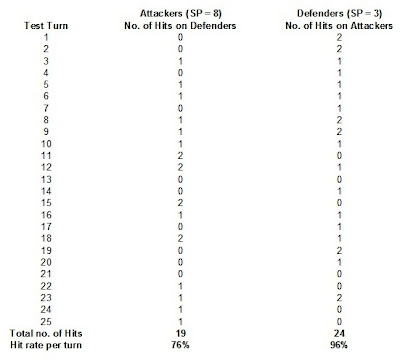The test scenario that I set up so that I could compare the outcomes of the HEXBLITZ and MEMOIR '44 combat systems was a simple one. I envisaged two Russian Rifle Regiments (rated as 'Trained'; each has an SP = 3) supported by an Artillery Regiment (also rated as 'Trained' and with an SP = 2) attacking (and hence 'Moving' against) a German Infantry Battalion (rated as 'Trained' and with an SP = 3) that was in a defensive position (and therefore 'Defensive'). (The ratings and order 'states' do not affect the outcome of the MEMOIR '44 results but do affect those generated using the HEXBLITZ system.)

First I recorded the outcome of twenty five combats using the existing HEXBLITZ combat system. Under this system each side totals up the SP of all the units involved in the combat and throws a D6 die for each SP. The results are read from the following table:

The results were as follows:

Under the existing HEXBLITZ combat system, although the Defenders are at a numerical disadvantage (3 SP as against the Attacker's 8 SP), their Defensive 'state' more that equalises the disadvantage. The Defenders had a 96% chance of inflicting a 'hit' on the Attackers whilst the Attackers only had a 76% chance of 'hitting' the Defenders. In none of the Test Turns would the Attackers have prevailed over the Defenders in a single turn.
I then recorded the outcome of twenty five combats using the MEMOIR '44 combat system. Under this system each unit 'battles' in turn. The procedure used is as follows:
I have aggregated the results to make the comparison somewhat easier. (Please note that I specifically only selected those results where the icon was either the soldier or the flag. I did not count the grenade icon as a 'hit'.)
The results were as follows:

Under the MEMOIR '44 combat system the numerical advantage enjoyed by the Attackers more that outweighs the fact that the Defending unit is behind sandbags. The Defenders had a 116% chance of inflicting a 'hit' on the Attackers whilst the Attackers had a 248% chance of 'hitting' the Defenders. In thirteen (!) of the twenty five Test Turns the Attackers would have prevailed over the Defenders.
These comparative tests are by no means conclusive (the test sample was too small) BUT they are indicative of the fact that replacing the existing HEXBLITZ combat system with the MEMOIR '44 combat system would seriously change the nature of the rules. This does not exclude the possibility that the MEMOIR '44 Battle Dice could be used in place of the standard D6 dice currently used in the HEXBLITZ rules BUT it would require a completely revised combat system.
First I recorded the outcome of twenty five combats using the existing HEXBLITZ combat system. Under this system each side totals up the SP of all the units involved in the combat and throws a D6 die for each SP. The results are read from the following table:

The results were as follows:

Under the existing HEXBLITZ combat system, although the Defenders are at a numerical disadvantage (3 SP as against the Attacker's 8 SP), their Defensive 'state' more that equalises the disadvantage. The Defenders had a 96% chance of inflicting a 'hit' on the Attackers whilst the Attackers only had a 76% chance of 'hitting' the Defenders. In none of the Test Turns would the Attackers have prevailed over the Defenders in a single turn.
I then recorded the outcome of twenty five combats using the MEMOIR '44 combat system. Under this system each unit 'battles' in turn. The procedure used is as follows:
- Identify the unit that is attacking (i.e. the Attacker) and which unit it is attacking (i.e. the Defender).
- Verify that the unit being attacked is within range or in contact with the attacking unit.
- If the attacking unit is Infantry or Armoured, verify that it has line-of-sight to the unit being attacked.
- Count out the number of Battle Dice to be thrown, based on the attacking unit's type (Infantry, Armoured, Artillery) unit and the range to the unit being attacked. (In this test scenario all the attacking Infantry normally throw three Battle Dice, as does the Artillery; the defending Infantry also normally throws three battle Dice.)
- Make any Battle Dice reductions due to terrain.
- The Battle Dice are thrown, and the icons on the battle dice determine the number of 'hits'.
I have aggregated the results to make the comparison somewhat easier. (Please note that I specifically only selected those results where the icon was either the soldier or the flag. I did not count the grenade icon as a 'hit'.)
The results were as follows:

Under the MEMOIR '44 combat system the numerical advantage enjoyed by the Attackers more that outweighs the fact that the Defending unit is behind sandbags. The Defenders had a 116% chance of inflicting a 'hit' on the Attackers whilst the Attackers had a 248% chance of 'hitting' the Defenders. In thirteen (!) of the twenty five Test Turns the Attackers would have prevailed over the Defenders.
These comparative tests are by no means conclusive (the test sample was too small) BUT they are indicative of the fact that replacing the existing HEXBLITZ combat system with the MEMOIR '44 combat system would seriously change the nature of the rules. This does not exclude the possibility that the MEMOIR '44 Battle Dice could be used in place of the standard D6 dice currently used in the HEXBLITZ rules BUT it would require a completely revised combat system.




























No comments:
Post a Comment
Thank you for leaving a comment. Please note that any comments that are spam or contain phishing messages or that come from Google Accounts that are 'Unknown' will be deleted.